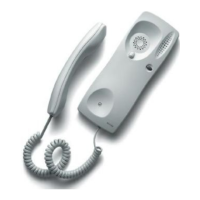51
Basic circuit diagram of door entry system insta-
llation in buildings with three entrances. Alcad mul-
tiple entrance systems are based on the use of
microprocessor-controlled audio units (microproces-
sor-based 4+N system). Rather than using change-
over switches to select one of the entrance panels,
the audio unit has been fitted with a microprocessor
that decides which entrance panel should be acti-
vated, and deactivates the rest of the panels in the
system.
This system simplifies the cabling of the installa-
tion, reduces the number of components and impro-
ves system operation.
Operation
One of the entrance panels in the system is cho-
sen to be the main panel just one panel per insta-
llation can be defined as the main one. To select
it, remove jumper J1 from the other entrance
panel. The main panel is the one which is con-
nected by default to the system’s telephones. The
other panels are only activated when one of the
call buttons is pressed.
When a call button is pressed, the correspon-
ding panel is activated to allow communication
with the telephones. The system busy indicator on
the other panels will start to flash to indicate that
they are disabled.
When a push button on one of the entrance
panels is pressed, the electronic call signal gene-
rated by the audio unit (7) is sent via the call line
to the corresponding telephone (5), where it is
heard on the loudspeaker of the handset. At the
same time the audio unit’s own loudspeaker gene-
rates a sound to confirm to the visitor that the call
has been made. The audio unit also generates a
control signal (17) that disables the other entrance
panels.
The audio unit starts a 30 second timer while it
waits for the telephone handset to be picked up. If
the handset is not picked up during this time, the
control signal (17) is removed and all three panels
go into the standby state.
If the handset is picked up during this time, the
electronics associated to the telephone’s audio
lines (3 and 4) is internally connected to the
entrance panel. This connection sets up the com-
munication between the telephone and the entran-
ce panel. The audio unit starts a fresh 60 second
period before removing the control signal (17)
and putting all three panels into standby state.
When only 10 seconds are left a buzz will be
heard. It is possible to restart the timer from the
dwelling end by pressing and releasing the tele-
phone hook switch. After finishing the communi-
cation, when the audio unit detects that the tele-
phone handset has been hung up, it removes the
control signal (17) and all three panels go into the
standby state.
When the door lock release button on the tele-
phone is pressed, the active audio unit detects the
closing of the lock release circut (1). The audio
unit then sends an a/c voltage (11 and 12) to the
electric lock connected to the active entrance
panel, thus allowing the entrance door to be ope-
ned.
The common wire (2) of the telephone and
entrance panel provides the return path for all the
telephone signals.
THREE ENTRANCE INSTALLATION WITH ELECTRONIC CALL
MICROPROCESSOR-BASED 4+N SYSTEM

